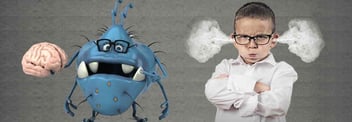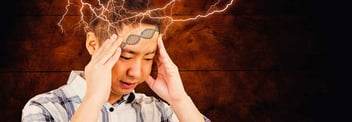I Have Trouble with Attention and Focus. Do I have ADHD?
- Home
- Blog

How do you know if you have ADHD? How is ADHD treated? If you have trouble with attention and focus in your everyday life, you may have Attention Deficit Hyperactivity Disorder (ADHD). This post offers a deep dive into:
- Signs and symptoms of ADHD
- How ADHD is diagnosed
- What causes ADHD
- Behavioral manifestations of ADHD
- ADHD treatment
What are the signs and symptoms of ADHD?
Many with ADHD feel a deep sense of frustration, anger and sadness that their brain does not work the way they wish it would. Some have even described their ADHD as “a curse.” Common ways ADHD manifests itself may include:
- Losing focus when trying to write or speak
- Failure to complete homework assignments and timed tests in the same time as others
- Learning new tasks takes a long time, regardless of intelligence. i ii iii
Another perspective on ADHD may be found in the song “Don’t Let Me Be Misunderstood,” by The Animals, which describes someone with good intentions, who has difficulty controlling and managing their emotions, has trouble tolerating frustration when things go wrong, and who feels misunderstood regarding their true intentions.
Here the lyrics relate to the moodiness that can accompany ADHD,v when the brain won’t cooperate with carrying out one’s intentions; and the person gets into trouble with loved ones who can’t understand mood swings, irritability, anger outbursts, and are not fully “present” during conversations; and where in turn the one suffering with the condition feels deeply misunderstood.
Also they may suffer from what I call “Ready… Fire… Aim” – acting impulsively before they think through or process information sufficiently. vi vii For the patient with ADHD, living in reality may feel like a “discontinuous experience,” as she or he repeatedly misses out on information and social cues in the surrounding environment.viii
When one’s speedix and efficiency of information processingx is compromised by distracting thoughts,xi xii one’s tongue may feel tied to the point of being unable to speak,xiii thoughts and behaviors may be chaotic and disorganized,xiv and feelings of anxiety xv ensue which make it difficult to settle down, the ADHD may lead to seeking out stimulation in the form of “addiction” to Web browsing (in “An Age of Distraction”)xvi xvii during homework or work assignments, risky behaviors, or substance abuse xx.
How is ADHD diagnosed?
A commonly used screening tool that rates the severity of the disorder is called the Adult ADHD – RS – IV. xxi Psychological testing is also useful in identifying subtypes and specific areas of weakness.xxii xxiii
Psychologist Dr. Marlena Wu notes that “a variety of assessment instruments can be used to assist the clinician, patient, and concerned family members in confirming whether or not ADHD is present; as well as determining relative areas of cognitive strength and weakness.” Parents in particular may wish to seek out this type of testing, as they may not want to place their children on stimulant medication in the absence of further confirmation.
In the United States, an estimated 4.4 percent of adults ages 18-44,xxiv 4 percent of children ages 4-8, and 9.7 percent of children ages 9-17xxv experience symptoms and some disability from ADHD. As such, this condition is one of the most common of all psychiatric disorders. The good news is that ADHD is associated with an exceptional response rate to treatment.xxvi
If you or a loved one needs to be screened for ADHD or your current ADHD treatment isn't working, contact us for an appointment.
What causes ADHD?
Research has established that ADHD is a neurobiological condition with a likely genetic component.xxvii xxviii
This means critical circuits in the frontal cortex of the brainxxix responsible for attention, organization, planning, and other executive functions are not functioning properly. The speed and efficiency of information processing is inconsistent, and compromised.xxx
These circuits mainly rely upon two neurotransmitters to function (dopamine and nor-epinephrine), and most medications used to treat ADHD increase the availability of one or both of these two transmitters.xxxi
Additional treatments typically include
- Education
- Cognitive/behavioral techniques that establish various routinesxxxii of daily living
- cardiovascular fitness exercise (Exercise activates the frontal cortexxxxiii in all age groups, and increases levels of both dopamine and nor-epinephrinexxxiv to improve ADHD symptoms)
Because patients are frequently distracted by wandering thoughts, excessive daydreaming, and external motion and sounds in the environment when trying to focus on a task, they miss out important events going on around them and struggle harder to learn new information.
Certain information from the environment therefore never “gets inside” their brain, and is unavailable to be processed, particularly when their “supply” of information processing is exceeded by the “demand” to process information while at school or in the workplace.
A useful analogy to explain this experience is to imagine that your computer suffers from ADHD. As a result, an average of one out of every ten keystrokes that you type never registers in the computer – that portion of the data never gets entered. In addition, the keystroke data that is “dropped” on the way in is random and unpredictable. The computer inconsistently processes the information that has been entered – at times with the latest chips, and at other times with microprocessor designed 20 years ago.
For simpler processing tasks this computer would function pretty well, but as processing complexity increased, it would function poorly, if at all. How well would the computer function with its varying processors that are commanded to process incomplete information? If you use your imagination, you can picture the result.
What are some behavioral manifestations of ADHD?
As Eric Burdon sings about in “Don’t Let Me Be Misunderstood,” those suffering from ADHD may be more prone to mood swings, swinging from a carefree, joyful, enthusiastic, spontaneous, and even entertaining self to another side filled with worry, anger and impulsivity.
Related behaviors can include poor frustration tolerance, irritability, difficulty waiting in lines or when stalled in traffic, restlessness, agitation, fidgeting, difficulty sitting still, and having a “short fuse.”xxxvi xxxvii
If you or someone you love suffers from these symptoms, how do they originate? What’s behind these self-sabotaging behaviors that are not intended?
An underlying clue relates to how challenging it can become to maintain stable positive self-worthxxxviii xxxix when one’s brain functions so inconsistently, and the speed and efficiency of processing external information and internal thoughts is so variable and unreliable. While our brains may function in certain respects like a computer, a machine lacks a heart. Having ADHD is not just cognitively challenging, it is emotionally painful, as learning new material becomes more of a struggle and takes longer than it does for others, social cues are missed, distractibility is interpreted as a “lack of interest” or “rudeness” by others, and self-esteem is diminished over time.
Anxiety, mood swings, and depression may set in. Patients with ADHD are more likely to develop a major depressive disorder, significant anxiety disorder, or substance abuse problem than the general population.xl xli Social development is slower and more challengingxlii due to missed social cuesxliii xliv and delayed brain maturation.xlv Symptoms may be masked by high intelligencexlvi and a strong work ethic, which provide for a temporary “work around” the ADHD processing deficits.
But as the complexity of life increases at certain transition points (for example moving from middle school to high school; taking standardized tests such as the SAT, LSAT, medical boards or bar examination; or receiving a significant promotion at work) the attentional system may become overwhelmed, emotional symptoms become more pronounced, and psychiatric care becomes necessary.
There has been increasing interest in adults with attention deficit problems in both the popular press as well as the psychiatric literature. Some of this results from a greater awareness that the attentional deficits of childhood often persist into adulthood;xlvii while other aspects relate to a pervasive anxiety over the need to perform at ever higher levels in the workplace, given the Great Recession and its attendant job loss and painfully slow recovery.xlviii xlix
Symptoms such as trouble sustaining attention, being easily distracted by internal or external stimuli, trouble staying on task, jumping from one task to another without completion, procrastination, problems with organization, difficulty focusing and executing on tasks particularly when they are boring, fidgeting, frequently being in motion, and interrupting others while they are speaking, are among the hallmarks of classic adult attention deficit disorder.l
There are four major areas of dysfunction under which most symptoms and behaviors of ADHD can be grouped. These include: li lii liii
- Executive function - trouble organizing, planning, following through on the plan, good time management
- Attention - inability to sustain a focus particularly when bored, easy distractibility, difficulty staying on task)
- Arousal level - people with ADHD tend to be under aroused, and may crave stimulation as they focus better with a higher arousal level
- Behavioral - for example fidgeting, restlessness, impulsivity, anger outbursts).
However, a note of caution is in order, given the risk that “Adult ADHD” may become over-diagnosed, and stimulants may become over-prescribed, much in the same fashion as childhood ADHD.liv It is important to recognize that there are many causes of disrupted attention in adults that bring about symptoms similar to adult ADHD, but have differing origins and treatments. So a careful diagnostic assessment is in order.
Some patients respond well to ADHD coaching to improve their ADHD symptoms and behaviors. Learn more about our ADHD coaching
How is ADHD treated?
If you believe that you, your partner, or child may have ADHD it is important that an expert in this condition conducts an evaluation and recommends a plan of treatment. Once treatment is underway, there are additional ways to help.
There are a variety of treatment options that were mentioned above including medication, cognitive behavioral therapy (CBT- which can also be a form of “ADHD Coaching”), and environmental manipulations including the provision of accommodations at work and at school.
The CBT therapy may involve analyzing the daily activities and required tasks, looking for the bottlenecks and roadblocks that interfere with achieving better results, and then designing, testing and implementing routines which, when practiced over and over again, can become embedded into daily life to improve effectiveness and efficiency.
If you are the parent of a child or adolescent with ADHD, it is best that someone else designs the routines and then supports your child in the implementation. If you take on this role, you may worsen your child’s preexisting oppositional and defiant behavior and struggles with your authority.
You can be more effective in helping your loved one by being supportive and encouraging around the routines that they have learned and provide reminders for them to use the routines they have learned if they begin to feel frustrated or upset with a cognitive challenge.
- If you are providing instructions or a list of items to take care of, put them in writing.
- Establish a location within your home that is fixed and inviolable for items such as eyeglasses, wallet, mobile telephone, and keys.
- Encourage daily cardio fitness exercise as this increases levels of dopamine and norepinephrine in the brain, providing a kind of natural stimulant-like effect.
Related Information
- Learn about Genetic Testing
- Learn about Potomac Psychiatry
- Meet Our Doctors
- Contact Potomac Psychiatry



